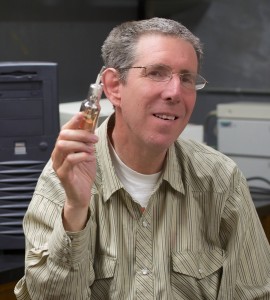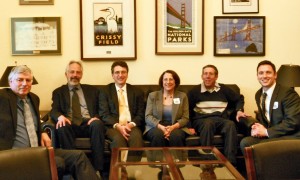Discovery. That, in large part, is what drives the human race forward. It’s also what drives California State University, Dominguez Hills physics professor and cutting-edge researcher Kenneth Ganezer.

Ganezer is also driven by the need to engage more students in science along with their faculty mentors, and as an officer of the California/Nevada section of the American Physical Society (APS), he traveled to Washington, D.C. and Greenbelt, Md. last semester to lobby for better funding for science as well as physics research and education to make that possible.
Ganezer along with four other physicists from Sonoma State University, University of California, Davis, UC Santa Barbara, and UC Santa Cruz were among approximately 50 APS representatives from throughout the nation who attended the four-day meeting sponsored by the National APS. The trip included a visit to Capitol Hill for Annual Congressional Day, during which the physicists visited the offices of the two senators from California and House representatives from their home district. Ganezer provided congressional staff members with documentation concerning the status of STEM (science, technology, engineering, and math) research and education at the university as well as the nationally, and attended a thank-you dinner in the National Press Club building.
“I was representing science in the U.S. in general, as well as Dominguez Hills,” said Ganezer, who is also coordinator of the pre-engineering program at the university. “Our first directive from the APS was to try to moderate the budget cuts that are going to come. Even though they are mandated by law, there could be other legislation to avoid or moderate possible cuts.”
He added that the opportunity to intervene was possible, in part, because the bi-partisan committee could not come to an agreement resulting in the sequestration of the federal budget.
Clementine Sessoms, grant development associate for research and funded projects at CSU Dominguez Hills, explaining the sequestration said, “The cuts are on hold until there’s some justifiable testimony that will support the continuance of funding or even additional funding.”
She also said the budget cuts–targeted at nine percent for non-defense discretionary accounts–or any successful action to reduce or eliminate them would affect all the agencies that support STEM initiatives.

Ganezer’s goal to mitigate cuts in STEM education was non-partisan. He said, “I lobbied to democrats to support President Obama’s budget for science, which actually increases it a little bit for major federal agencies that support science, such as NSF and the department of energy, the department education, and NASA. In addition, we asked democrats to support a balance between strategic defense related scientific initiatives and basic discovery science which is research.”
On the other side of the aisle, he and his colleagues urged republicans “to support initiative for competiveness in science, the America COMPETES (Creating Opportunities to Meaningfully Promote Excellence in Technology, Education, and Science) Act.” The Act, signed into law in 2009 by George W. Bush, supports efforts to double funding for basic research in the physical sciences.
Sessoms said Ganezer’s visit to Washington was a rare opportunity for faculty to interact with staff from congressional offices to promote the support of physical science research as a part of STEM education from kindergarten through graduate school, and that the nation is lagging behind globally in STEM initiatives.
Ganezer added, “There are commercials on television about how we’re 25th in the world in science education.”
Sessoms responded, “And those are real numbers. So, this is a call for action in universities, schools, and professionals. If we expect to be competitive, what do we consider as our priorities? We have an obligation and responsibility to ensure students get the support they need so they can move through science programs.”
She pointed to programs at CSU Dominguez Hills that have been effective in driving students toward science, such as the Minority Biomedical Research Support (MBRS), Research Initiative for Scientific Enhancement (RISE), Minority Access to Research Careers (MARC), and Undergraduate Student Training in Academic Research (USTAR) programs. She added that through financial support and mentoring they are helping students succeed in fields they otherwise may not even consider. Nevertheless, it’s still a challenge.
“The hardest thing to do is to get students into the math related physical sciences and natural sciences, with physics being the most difficult,” said Ganezer.
However, he’s doing his best to overcome that beginning with efforts at CSU Dominguez Hills and on Capitol Hill.